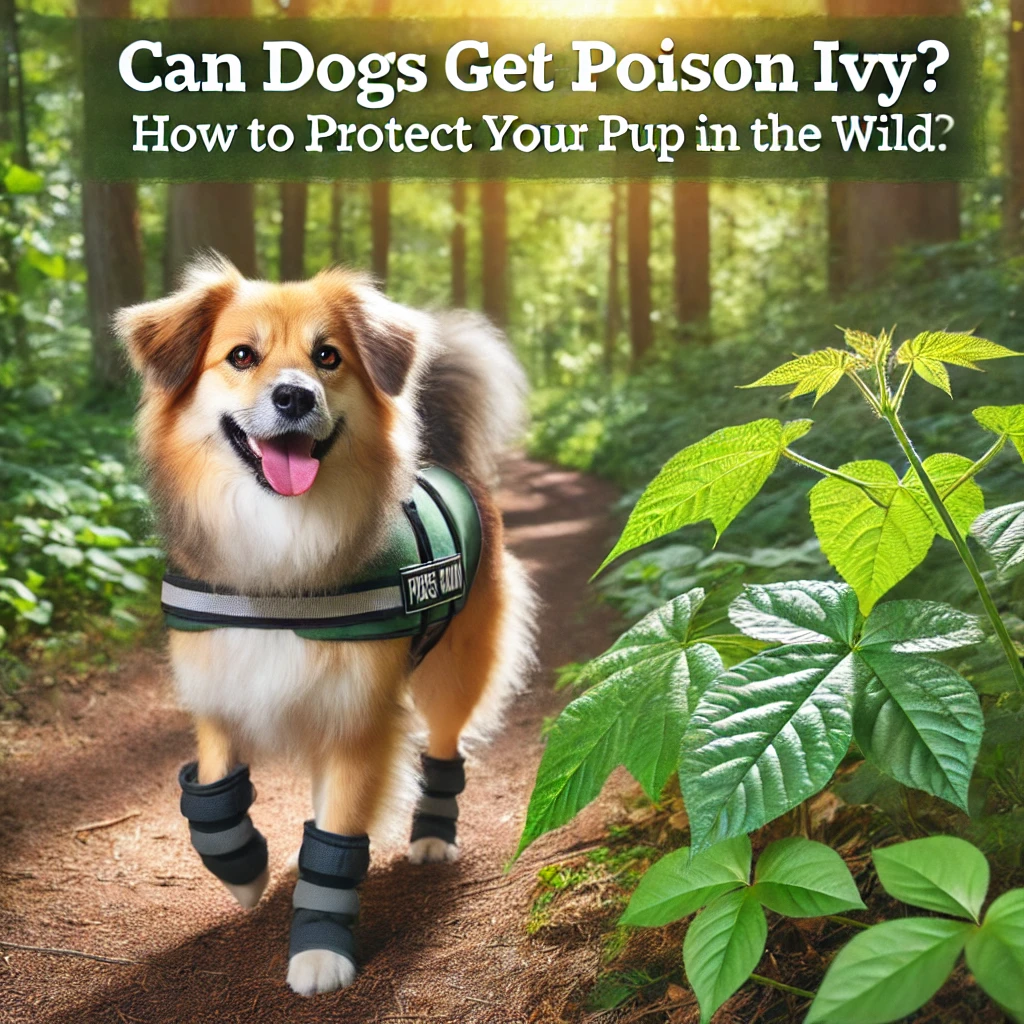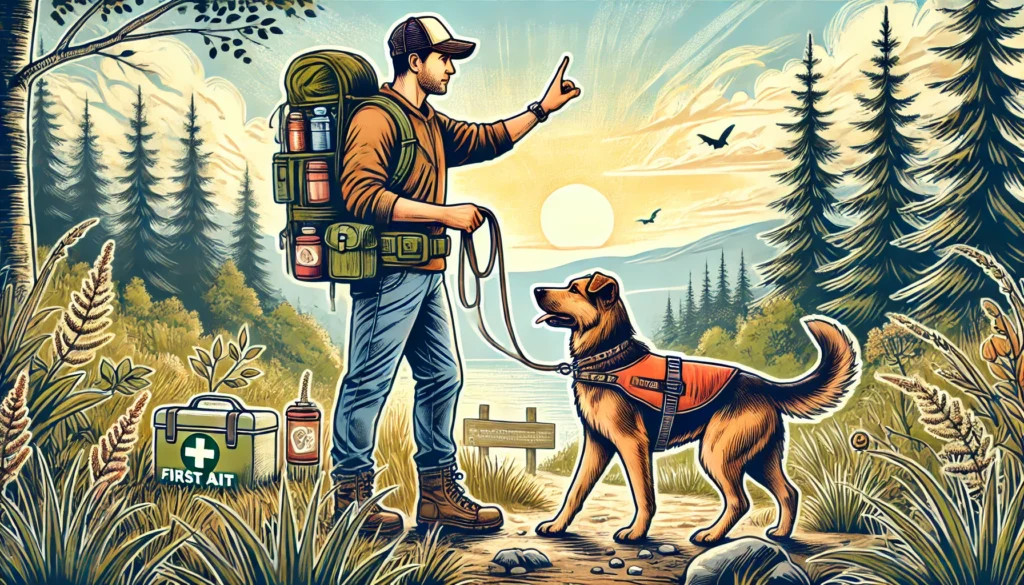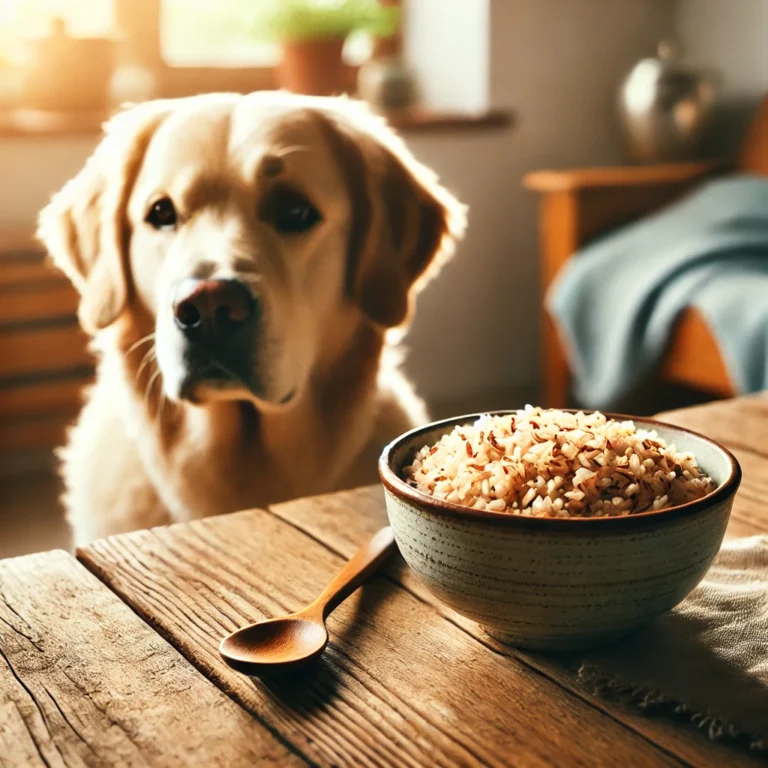
You’re hiking through a lush forest trail, your dog happily sniffing and exploring beside you.
The scenery is breathtaking—but lurking among the greenery might be an unwelcome guest: poison ivy.
Can dogs get poison ivy, and what should you do to protect your furry companion in the wild?
This post breaks down the facts, symptoms to watch for, and how to keep your dog safe, plus offers a few essential products that can make all the difference.
What is Poison Ivy and Why is it Dangerous?
Poison ivy is a common plant in North America, recognizable by its signature clusters of three leaflets, often prompting the cautionary rhyme, “Leaves of three, let it be.”
The plant thrives in a wide range of environments, from forest trails and parks to backyards and open fields.
Its ability to grow in various conditions makes it a potential threat during outdoor activities with your furry companion.
The reason poison ivy poses a danger lies in its secretion of a resinous oil called urushiol.
This oily compound is present on the plant’s leaves, stems, and roots, and it is incredibly potent—even a small amount can trigger an allergic reaction in many humans.
When a person or pet comes into contact with urushiol, it binds to the skin, causing an itchy, blistering rash.
While humans are especially sensitive to urushiol, dogs are somewhat protected due to their fur, which often acts as a barrier.
However, there are still key concerns:
Risks for Dogs
- Sensitive Areas: Dogs with short fur, thin hair, or exposed skin (like the belly, face, or paws) are more likely to experience irritation upon contact with urushiol.
- Urushiol Transfer: Even if a dog doesn’t react to poison ivy itself, the oil can transfer to humans if you pet your dog after they’ve been exposed, causing a reaction in you or other people.
How Urushiol Works
Urushiol is incredibly tenacious—it can remain active on surfaces for a long time, including clothing, pet fur, and even camping gear.
When it touches the skin, the immune system recognizes it as a threat, resulting in a delayed allergic reaction that can vary from mild itching and redness to severe blistering and swelling.
Impact on Pets vs. Humans

- Dogs: Many dogs don’t show symptoms immediately due to their protective coat. However, exposure to urushiol can still lead to irritation, especially in sensitive areas.
- Humans: Contact with poison ivy is typically far more severe, as most people are sensitive to urushiol. If a dog comes into contact with the plant and transfers the oil to their owner, the person may develop a rash.
In summary, poison ivy’s danger stems from its urushiol oil, which can cause intense irritation in those sensitive to it.
While dogs are less vulnerable than humans, they can still experience discomfort and pose a secondary risk to their owners through indirect exposure.
Therefore, it’s important to recognize and avoid this plant during outdoor activities.
Can Dogs Get Poison Ivy?
The short answer is yes, but it’s rare compared to humans.
Dogs have a protective coat that often prevents the urushiol oil from reaching their skin.
However, dogs with shorter fur or sensitive areas, like the belly, face, and paws, are more susceptible.
If your dog brushes against poison ivy, they may show signs of irritation.
Symptoms to Watch For if Your Dog Has Been Exposed to Poison Ivy
While it’s relatively uncommon for dogs to experience severe reactions to poison ivy due to their protective coat, they are not entirely immune.
If your dog comes into contact with poison ivy, there are certain signs and symptoms to watch for that indicate potential exposure and irritation.
Recognizing these symptoms early can help you take the necessary steps to minimize your dog’s discomfort and prevent further complications.
1. Excessive Itching and Scratching
One of the first signs of exposure to poison ivy in dogs is increased scratching, licking, or biting at the affected area.
Dogs may try to relieve the itching and irritation caused by the urushiol oil. You might notice them:
- Constantly pawing at their face, ears, or other sensitive areas.
- Rubbing themselves against furniture, the ground, or walls to scratch an itch.
2. Redness and Inflammation
If your dog’s skin comes into contact with poison ivy, it may develop localized redness or irritation.
This is especially common in areas with less fur coverage, such as:
- The belly
- Inner thighs
- Ears
- Around the eyes or nose
- Paws
3. Blisters or Small Bumps
In more severe cases, dogs can develop small blisters or raised bumps on their skin due to contact with urushiol.
Blisters may ooze or become crusty over time, which can increase the risk of infection if your dog continues to scratch.
4. Swelling
Swelling around the face, eyes, or affected skin areas can occur as part of the body’s reaction to urushiol exposure.
This is particularly concerning if it leads to facial swelling, as it could potentially interfere with breathing or cause additional discomfort.
5. Persistent Licking and Chewing of Paws
The paws are one of the most common areas where dogs may encounter poison ivy, especially if they run through wooded or brushy areas.
If your dog is licking or chewing its paws excessively after outdoor exposure, it could indicate contact with poison ivy or similar irritants.
6. Drooling or Mouth Irritation
If your dog comes into contact with poison ivy using its mouth or snout, you may notice drooling, redness around the lips, or pawing at the mouth.
This can happen if they try to sniff or chew on the plant.
7. Hair Loss or Thinning Coat in Affected Areas
If the irritation is severe, you may observe hair loss or thinning of the coat in areas where your dog has been scratching or licking frequently.
Persistent scratching can lead to bald spots, scabs, or skin damage.
8. Behavioral Changes
In some cases, dogs may become irritable, restless, or unusually anxious due to the discomfort caused by poison ivy exposure.
If your normally calm dog appears agitated or has difficulty settling down, it could be a sign of underlying irritation or itching.
When to Contact a Veterinarian

While most cases of poison ivy exposure in dogs can be managed at home with prompt and proper care, there are situations where veterinary attention is necessary.
Contacting a veterinarian ensures your dog receives appropriate treatment, prevents complications, and eases your pet’s discomfort quickly.
Here’s when you should reach out to a professional:
1. Symptoms Persist or Worsen
If your dog’s symptoms do not improve within a few days of home care—or if they start to get worse—contact your veterinarian.
Persistent itching, redness, or irritation that does not subside may indicate that your dog’s exposure was more severe than initially thought, or it could signal the development of an infection due to excessive scratching.
2. Severe Blisters, Sores, or Open Wounds
If your dog develops large blisters, open sores, or any signs of broken skin, it’s important to seek veterinary care.
Open wounds are prone to infection, and professional cleaning and treatment may be required to prevent complications.
The vet may recommend topical ointments, antibiotics, or other remedies to aid healing.
3. Significant Swelling
Swelling, especially around the face, eyes, mouth, or throat, can indicate a more serious reaction to poison ivy exposure.
If your dog’s eyes are swollen shut, if their mouth is inflamed, or if there is any sign of difficulty breathing, immediate veterinary care is essential.
Facial swelling could also signal an allergic reaction, which may require prompt intervention to avoid serious complications.
4. Difficulty Breathing or Respiratory Distress
Although rare, dogs may experience respiratory distress if they inhale or ingest urushiol from poison ivy.
If you observe any signs of labored breathing, wheezing, coughing, or excessive drooling, treat it as an emergency and take your dog to the veterinarian right away.
5. Persistent Itching and Extreme Discomfort
If your dog is showing signs of extreme discomfort, such as incessant scratching, whining, pacing, or restlessness, this may indicate a severe reaction.
Your veterinarian can provide medications to soothe itching and reduce inflammation, such as antihistamines, steroids, or other treatments tailored to your pet’s needs.
6. Signs of Infection
Be on the lookout for signs that your dog’s skin is becoming infected due to scratching or exposure to irritants.
Symptoms of infection may include:
- Red, inflamed skin that feels hot to the touch.
- Pus or discharge from sores or blisters.
- Foul odors emanating from affected areas.
- Increased sensitivity or pain when touched.
Infected skin can become a more serious health problem if left untreated, so it’s important to have it assessed by a vet as soon as possible.
7. Symptoms That Do Not Match Typical Poison Ivy Reactions
If your dog exhibits symptoms that seem unusual or do not align with a typical reaction to poison ivy, consult your veterinarian.
Dogs may come into contact with other toxic plants or substances that cause similar skin reactions, and a professional evaluation can help determine the exact cause and appropriate treatment.
8. Extreme Fatigue, Loss of Appetite, or Behavioral Changes
If your dog becomes lethargic, loses interest in food, or shows significant changes in behavior (e.g., avoiding human interaction, excessive sleepiness, or irritability), it could indicate a more serious underlying reaction to the exposure.
Your veterinarian will be able to assess your dog’s overall health and provide the necessary care.
What to Expect During a Veterinary Visit
When you bring your dog to the veterinarian for potential poison ivy exposure, here’s what may happen:
- Physical Examination: The vet will carefully examine the affected areas to determine the severity of the reaction.
- Diagnosis: If necessary, tests may be conducted to rule out other causes of irritation or to confirm exposure to poison ivy.
- Treatment Plan: Depending on the severity, treatment may involve topical medications, anti-itch sprays, oral antihistamines, or prescription-strength anti-inflammatories. In case of infection, antibiotics may be prescribed.
- Aftercare Instructions: The veterinarian will provide guidance on home care, cleaning, and monitoring your dog’s recovery.
By recognizing when to contact a veterinarian, you can ensure that your dog receives the care they need to recover comfortably and safely.
While poison ivy exposure may be uncommon in dogs, it’s always better to err on the side of caution and seek professional advice if you’re unsure about your pet’s condition.
Get your dog comfortable and prevent further complications.
Simple actions, such as bathing your dog with a gentle shampoo and keeping a close eye on their behavior, can make a big difference in their recovery and overall well-being.
How to Protect Your Pup in the Wild

When venturing outdoors with your dog, there are countless wonders to explore—but there are also potential hazards, such as poison ivy.
While the allure of the wilderness makes for memorable adventures, pet parents must be proactive in safeguarding their furry friends.
Here’s how you can effectively protect your pup in the wild from poison ivy and other risks:
1. Learn to Identify Poison Ivy
The first line of defense against poison ivy is being able to recognize it.
Poison ivy typically grows as a vine or low shrub with leaves that come in clusters of three, often with a shiny surface.
Depending on the season, its appearance may change:
- Spring/Summer: Bright green or reddish leaves.
- Fall: Leaves may turn yellow, red, or orange.
- Winter: Bare vines can still carry urushiol oil.
Familiarize yourself with this plant and point it out to your dog if possible.
It helps you avoid areas where it grows, making it less likely that your pet will have an encounter.
2. Stick to Designated Trails
When hiking or exploring wooded areas, keep your dog on designated paths and trails.
Venturing off the beaten track increases the likelihood of coming into contact with poison ivy and other potentially harmful plants.
By sticking to known trails, you reduce your dog’s exposure to hidden dangers.
3. Use Dog-Safe Barrier Products
Consider applying a protective barrier product designed for pets.
These products form a layer that helps shield your dog’s skin and coat from irritants like urushiol oil.
While not a foolproof solution, it can be an additional layer of protection.
- Recommended Product: Dog Protective Spray – Helps create a barrier against allergens and irritants.
4. Dress Your Dog for Outdoor Adventures
Outfitting your dog with protective clothing can minimize direct contact with poison ivy.
Consider using dog boots, bandanas, or lightweight protective shirts for additional coverage, especially for dogs with sensitive skin or short fur.
- Suggested Items: Dog Hiking Boots and Lightweight Protective Dog Clothing
5. Supervise and Train Your Dog
Dogs are naturally curious and may sniff or chew on unfamiliar plants, potentially exposing themselves to poison ivy.
Keep a close eye on your dog during outdoor excursions, and use commands like “leave it” or “come” to redirect them away from areas of concern.
Proper training can significantly reduce their chances of interacting with potentially harmful plants.
6. Clean Your Dog After Outdoor Activities
Even if you’ve taken precautions, your dog may still brush against poison ivy.
When you return home from a hike or outdoor activity, take a few minutes to clean their fur, especially focusing on their paws, legs, and belly.
Use pet-safe wipes or rinse your dog with water to remove any potential traces of urushiol oil before it transfers to you or lingers on your pet.
- Recommended Cleaning Supplies: Pet Cleaning Wipes for sensitive skin or Gentle Dog Shampoo for a full bath.
7. Avoid High-Risk Areas During Peak Seasons
Poison ivy thrives in many areas, especially during warmer months.
To minimize the risk, consider avoiding heavily wooded or overgrown areas during peak poison ivy seasons (spring through fall).
Instead, choose dog-friendly parks and trails where vegetation is well-maintained.
8. Use Leashes and Harnesses
Keeping your dog on a leash, especially in unfamiliar areas, gives you more control over their movements.
This makes it easier to guide them away from potentially hazardous plants like poison ivy.
Opt for a sturdy harness and a reliable leash that keeps your dog close while allowing them enough freedom to explore safely.
9. Inspect and Groom Your Dog Regularly
Regular grooming and inspections can help you catch signs of poison ivy exposure early.
Brushing your dog’s fur after walks, examining their skin for irritation, and checking for any plant debris will keep your pup clean and help you spot potential issues quickly.
10. Educate Yourself About Similar Plants
Besides poison ivy, there are other plants—like poison oak and poison sumac—that can also pose risks.
Educating yourself on these and any local plant species that might irritate your dog is crucial for proactive protection.
Bonus Tip: Keep a Pet First Aid Kit Handy

Having a pet-specific first aid kit with items like gentle cleansers, dog-safe anti-itch sprays, and gloves to handle potential irritants can make all the difference in case of accidental exposure.
Be prepared for any situation and know how to provide immediate care.
By following these protective measures, you can enjoy outdoor adventures with your dog while minimizing the risks associated with poison ivy.
Being aware, prepared, and proactive keeps both you and your furry companion safe, ensuring your excursions into the wild remain fun and worry-free.
What to Do If Your Dog is Exposed to Poison Ivy
Even with the best precautions, there may be instances when your dog comes into contact with poison ivy.
Recognizing the signs and taking swift action can prevent discomfort for your pet and help you avoid accidental exposure to urushiol oil.
Here’s what to do if your dog is exposed to poison ivy:
1. Protect Yourself First
Before you begin handling your dog, protect yourself by wearing gloves and long sleeves.
Urushiol oil, the irritant in poison ivy, can easily transfer to human skin from your dog’s fur, leading to itching and rashes.
Use disposable gloves if possible, and be careful not to touch your face, eyes, or skin while handling your pet.
2. Move to a Safe, Clean Area
If you suspect your dog has come into contact with poison ivy, immediately move them away from the area to prevent further exposure.
Bring them indoors or to a controlled environment where you can clean them without distractions.
3. Rinse Your Dog Thoroughly
Rinse your dog with cool water to help remove any urushiol oil from their fur.
Use a garden hose outdoors or take them directly into a bathtub or shower.
Be sure to focus on their paws, legs, belly, and any other areas with minimal fur coverage.
Rinsing thoroughly is key to reducing the risk of the oil spreading.
4. Use a Gentle Dog Shampoo
After rinsing, bathe your dog with a gentle, pet-safe shampoo to remove any remaining oil.
Work the shampoo into a lather, taking care to scrub all areas of your dog’s coat.
Avoid using human shampoos, as these can cause irritation. Rinse thoroughly to ensure all soap and oil are washed away.
- Recommended Product: Hypoallergenic Dog Shampoo – Ideal for sensitive skin and removing allergens.
5. Dry Your Dog Carefully
Pat your dog dry with a towel and avoid vigorous rubbing, as this can spread any remaining oil.
If you suspect that urushiol oil may still be present, use disposable towels and wash your hands thoroughly after handling the towel and your dog.
6. Clean Your Dog’s Accessories
Any accessories your dog was wearing, such as collars, harnesses, or leashes, should be cleaned thoroughly.
Urushiol oil can linger on surfaces, so wash these items with soap and water or use a pet-safe cleaning solution.
Consider wearing gloves during this process.
7. Monitor Your Dog for Symptoms
After exposure, watch your dog closely for any signs of irritation or allergic reaction.
Common symptoms include excessive scratching, redness, swelling, or the appearance of small blisters on their skin.
Pay particular attention to sensitive areas like the belly, paws, and face.
8. Apply a Dog-Safe Topical Treatment (If Needed)
If your dog’s skin shows signs of mild irritation, you can use a vet-approved anti-itch spray or cream to soothe the affected areas.
Be cautious about using any over-the-counter human products, as many can be harmful to pets.
- Suggested Product: Pet-Safe Anti-Itch Spray
9. Prevent Licking and Scratching
If your dog seems particularly itchy, try to prevent excessive licking or scratching, as this can worsen the irritation and lead to secondary infections.
You may need to use an Elizabethan collar (cone) to stop your dog from accessing affected areas.
10. Wash Your Own Skin and Clothes
After handling your dog and any items they came into contact with, wash your hands thoroughly with soap and water.
It’s also a good idea to wash your clothing and any towels used during the cleaning process to remove any lingering urushiol oil.
11. Know When to Seek Veterinary Care
Contact your veterinarian if:
- Your dog’s symptoms persist or worsen over a few days.
- Blisters, sores, or swelling become severe.
- Your dog appears to be in significant discomfort or pain.
- Your dog experiences any difficulty breathing or shows signs of an allergic reaction.
A veterinarian can provide professional guidance and treatment, which may include medicated ointments, antihistamines, or additional support to ease your dog’s symptoms.
What to Avoid Doing

- Don’t Use Human Poison Ivy Treatments: Many creams and ointments formulated for human use contain ingredients that can be toxic to dogs. Always consult your vet before using any topical products.
- Don’t Delay Bathing Your Dog: The sooner you wash your dog, the better your chances of removing urushiol oil and minimizing irritation.
- Don’t Allow Your Dog to Roam Freely: Until your dog is fully cleaned and inspected, avoid letting them roam freely indoors to prevent the spread of urushiol oil to furniture, carpets, and family members.
By following these steps, you can effectively manage your dog’s exposure to poison ivy, reduce their discomfort, and protect yourself and your household from further irritation.
Quick action, proper cleaning, and monitoring will help ensure your furry friend stays happy and healthy after any outdoor mishap.
Myths and Misconceptions About Dogs and Poison Ivy
- Myth 1: Dogs Can’t Pass Poison Ivy to Humans
False. Urushiol can stay on a dog’s fur and transfer to you during petting, so it’s important to wash your dog after suspected exposure. - Myth 2: All Dogs React the Same Way
False. Reactions can vary depending on the breed, fur length, and sensitivity of the dog.
Natural and Medicinal Treatments
- Oatmeal Baths: Oatmeal can help soothe itching and inflammation naturally.
- Aloe Vera Gel: If approved by your vet, aloe vera may relieve irritated areas.
- Affiliate Link Suggestion: Organic Aloe Vera Gel for Pets
Conclusion
Keeping your dog safe from poison ivy is all about preparation and awareness.
By taking preventive measures, using protective gear, and knowing how to respond to exposure, you can enjoy the great outdoors worry-free with your furry friend.
Do you have any experiences with your dog and poison ivy? Share your story in the comments below!
And don’t forget to check out our recommended protective products for your next outdoor adventure.
Top 5 Best Carpet Cleaner for Pets You Can Buy: Tested and Reviewed
How to Make Homemade Dog Food (Recipes Included!): Tips from Pet Nutritionists
As an Amazon Associate, I earn from qualifying purchases.



